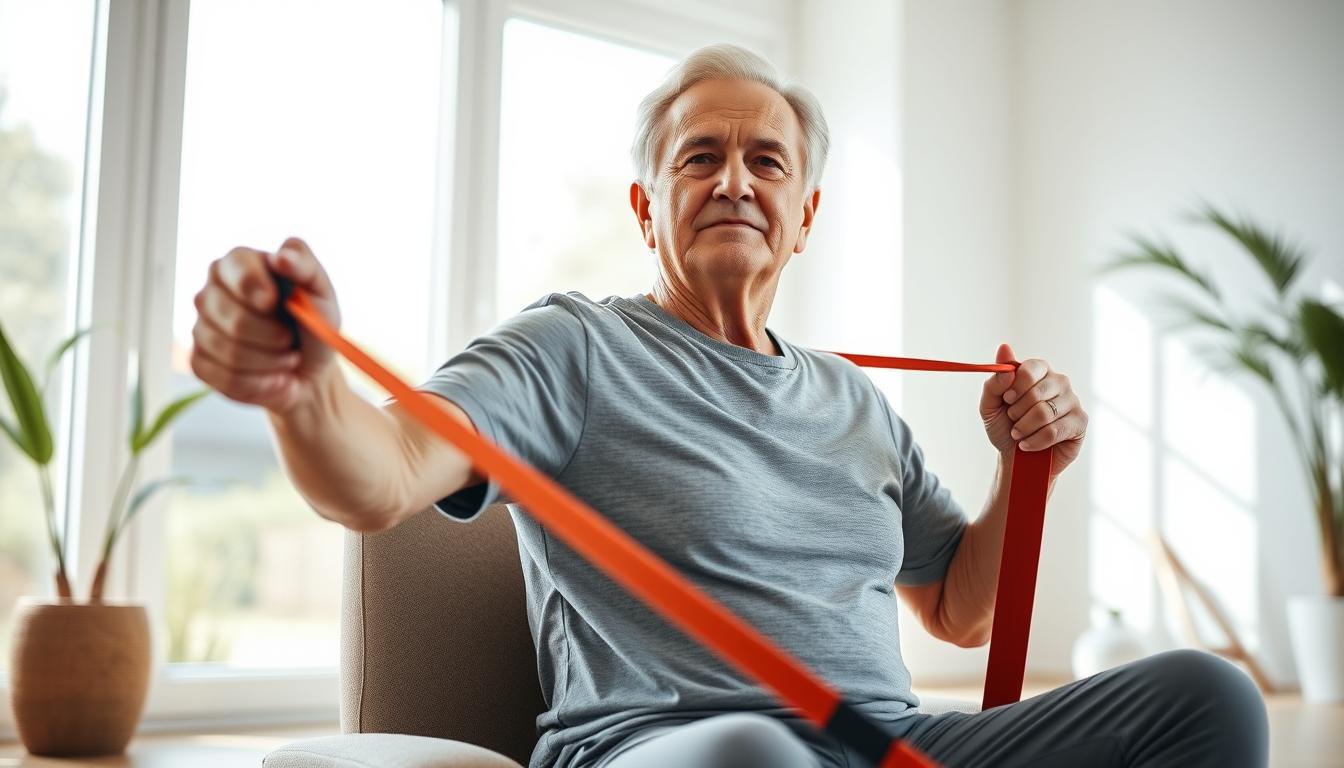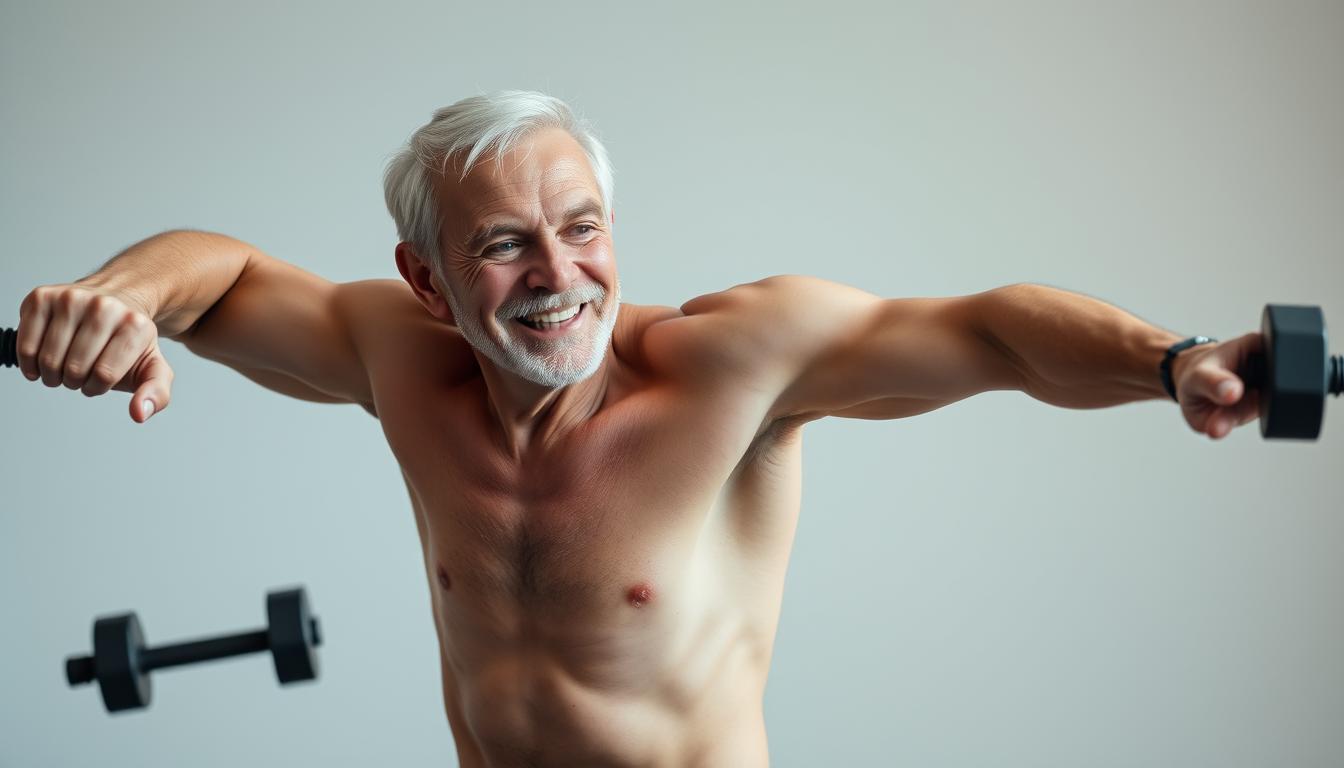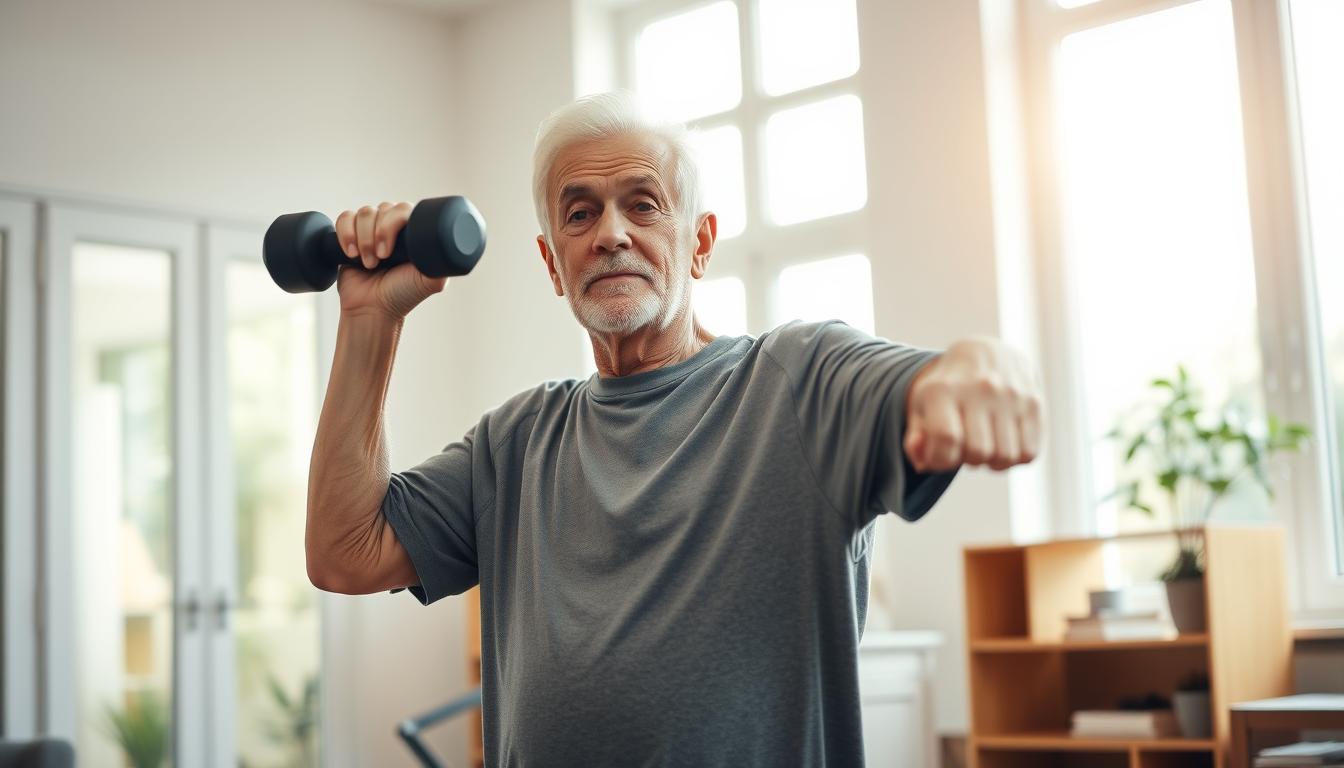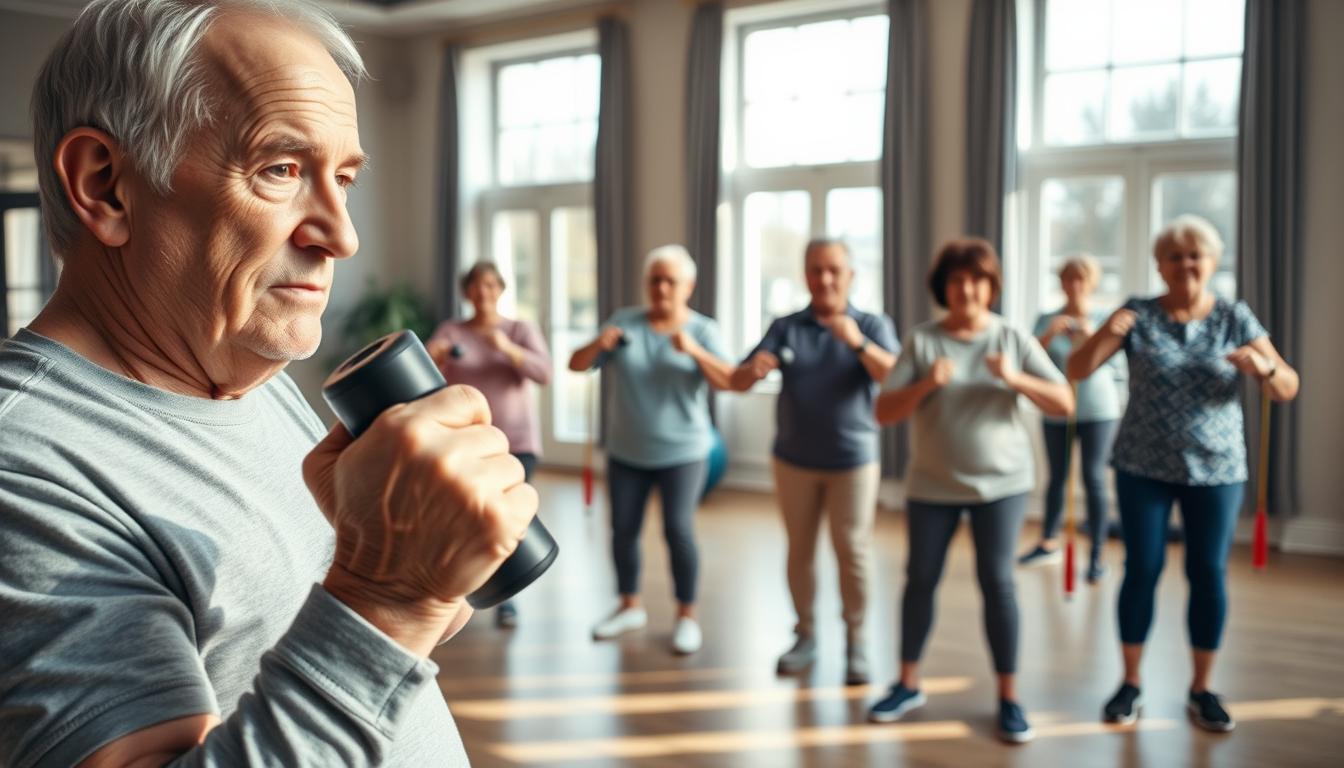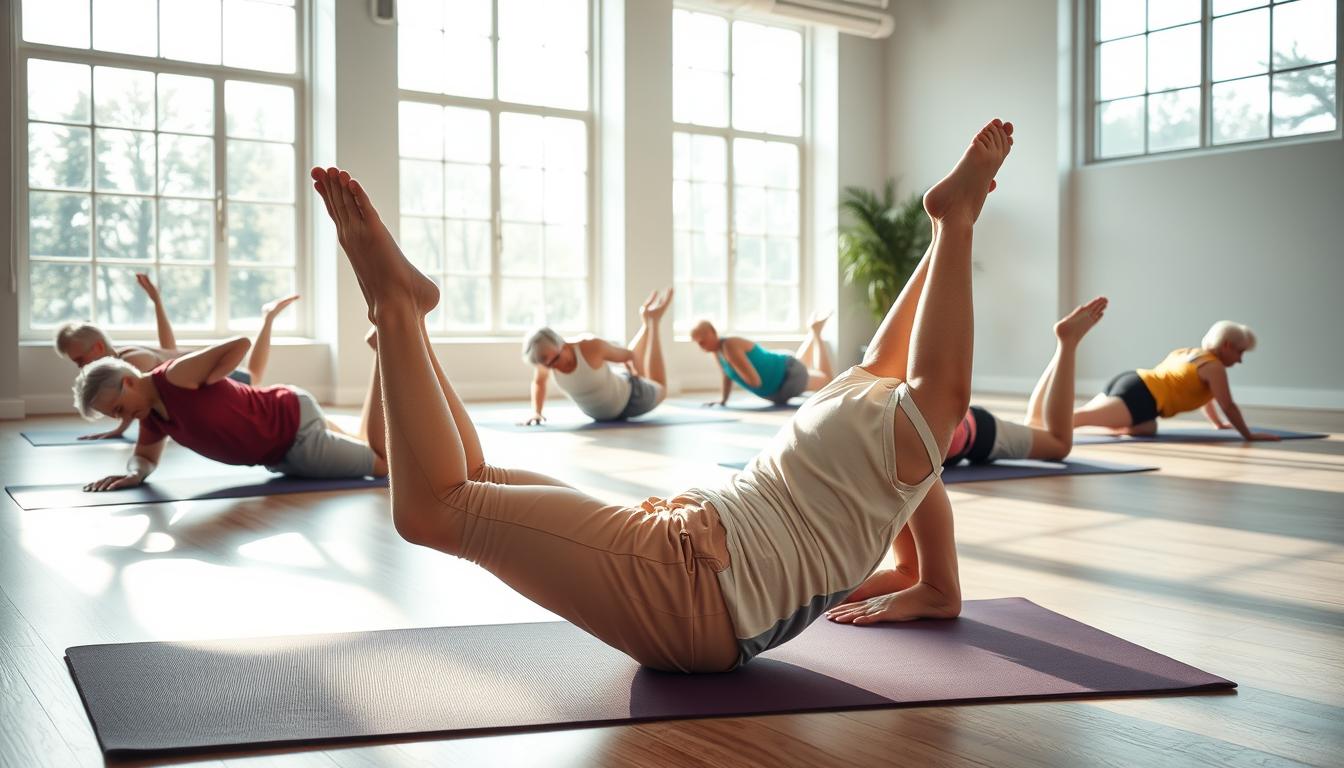Let’s cut to the chase: you don’t need perfect joints to build strength. A sturdy chair and 10 minutes a day can keep you mobile, even if your knees creak like an old floorboard. I’ve seen folks in their 70s out-lift gym bros using nothing but a dining room seat and determination.
Physical therapist Tobi Jevnikar once told me, “The best workout is the one you’ll actually do.” That’s why these moves target your legs without demanding acrobatics. Picture this: seated leg lifts while binge-watching Blue Bloods, or pressing a soup can overhead during commercial breaks. No $200/month gym membership required.
Here’s the kicker: your chair isn’t just furniture—it’s a resistance machine in disguise. I’ve used mine to build quads strong enough to hike Sedona trails again. And yes, canned vegetables count as weights. (Pro tip: opt for chickpeas. Dinner and dumbbells?)
You’ll nail three things here: stronger legs, better balance, and proof that age really is just a number. Ready to turn your living room into a pain-free powerhouse? Let’s roll.
Understanding the Benefits and Basics
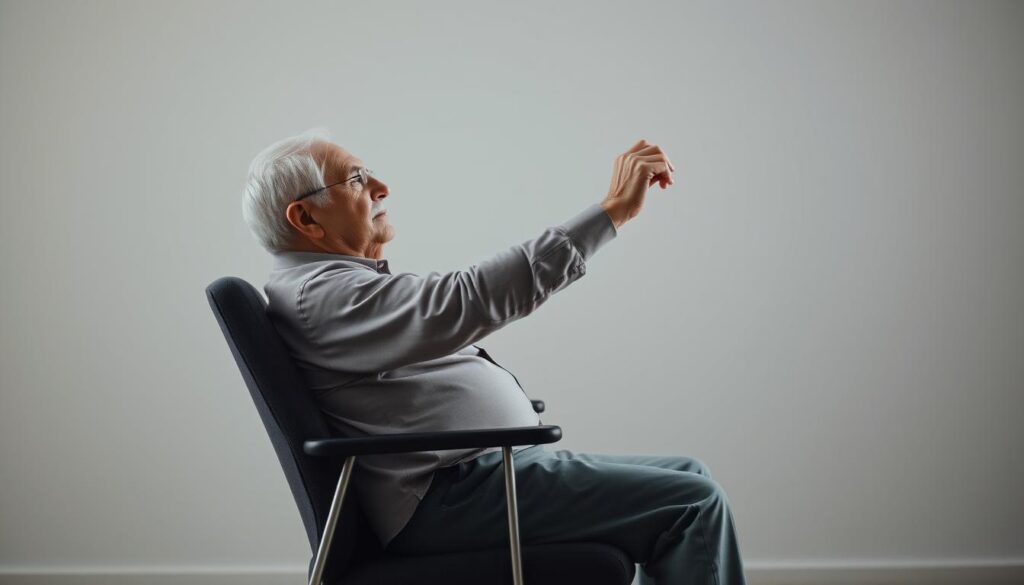
Here’s the truth nobody tells you about aging: your kitchen chair is a secret weapon. Those 10 minutes you spend scrolling Facebook? Perfect for building stability. I once watched my neighbor lift her grandbaby with ease after six weeks of chair workouts—her secret? Starting with the basics.
First, plant your feet flat like you’re stomping grapes. This isn’t just about comfort—research shows firm contact with the floor boosts balance by 23% during movements. Keep your back pressed into the chair like it’s your dance partner. Hands? Rest them on your thighs like you’re holding down newspaper in a breeze. This position turns your body into a stable tripod.
| Standing Exercise | Chair Version | Real-Life Benefit |
|---|---|---|
| Lunges | Seated leg extensions | Easier stair climbing |
| Planks | Chair-assisted leans | Carrying groceries |
| Squats | Stand-sit repetitions | Loading laundry |
Why does this work? Your joints get support while muscles do the heavy lifting. That pot of pasta water you struggle with? Chair workouts build the exact muscles needed to hoist it safely. My physical therapist friend calls this “stealth strength training”—you’re building capability without feeling like you’re working out.
Pro tip: Imagine your spine is a stack of quarters. Slouching? That’s money on the floor. Proper alignment protects your back while letting your legs and core strengthen naturally. Next time you reach for the top shelf, you’ll feel the difference.
Proper Chair Selection and Setup
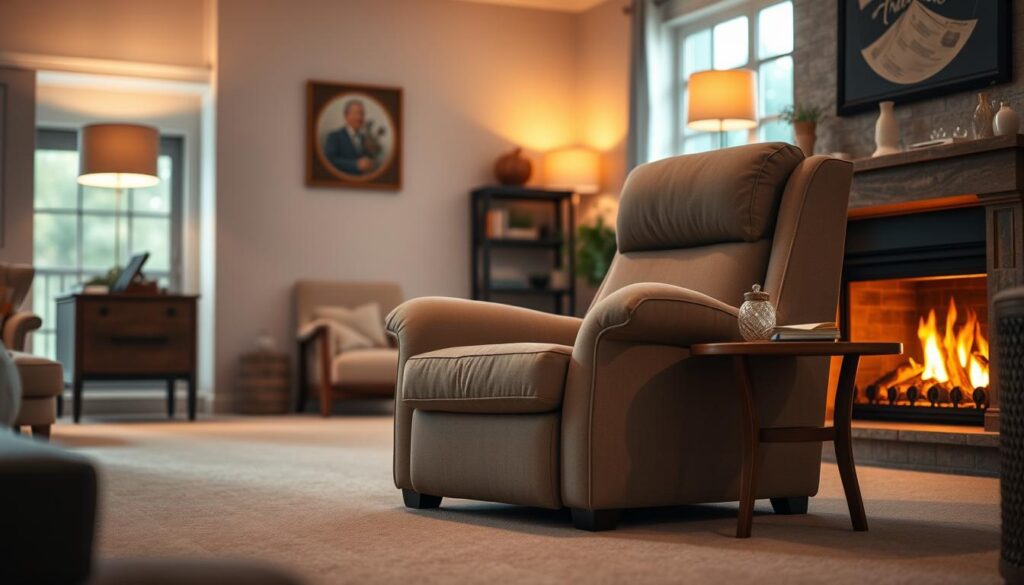
You know that wobbly barstool in your kitchen? Let’s banish it to the garage. The right chair turns your workout from risky to rock-solid—think sturdy legs, not swivel seats. I learned this the hard way when my aunt’s recliner nearly tipped during leg lifts. Dining room table chairs usually work best.
Choosing a Stable, No-Wheel Chair
Test your chair like you’re judging a diving board. Push sideways—if it slides, it’s out. A firm seat keeps your hips aligned, while a rigid front edge lets you lean forward safely. Those plastic patio chairs? Perfect if they don’t flex when you shift your weight.
Avoiding Chairs with Armrests and Soft Cushions
Armrests are sneaky strength saboteurs. They trap your arms when you should be moving them freely at your sides. Plus, fluffy cushions? They sink your hips like quicksand, straining your knees. “It’s like doing crunches on a waterbed,” my neighbor grumbled after her plush office chair caused back pain.
Here’s the golden rule: flat seat, straight back, four legs. Picture a wooden kitchen chair—no wheels, no padding, no nonsense. Your future self will thank you when you’re lifting groceries without wincing.
Warming Up with Safety and Mobility Routines
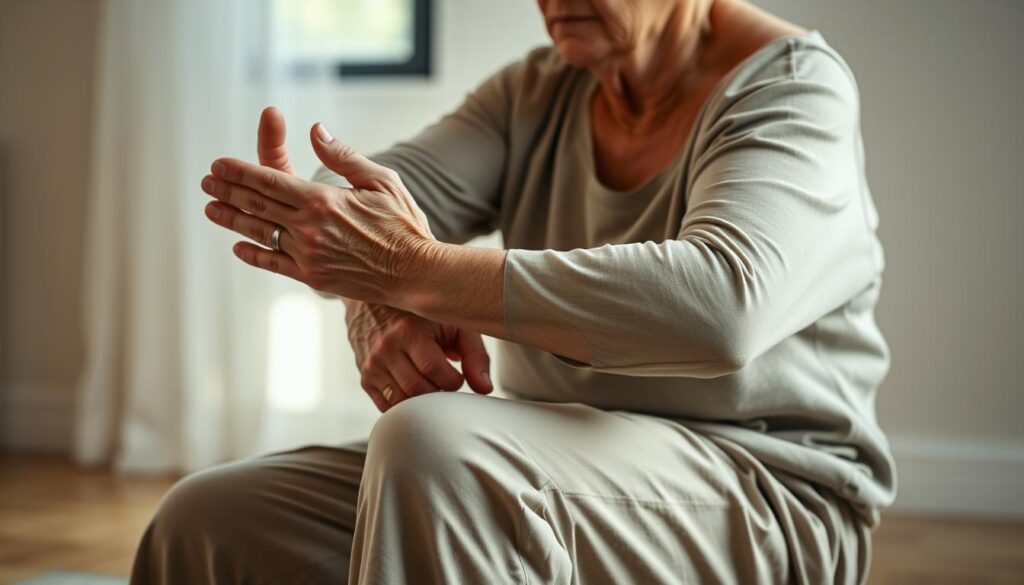
Your favorite recliner just became a launchpad. Warming up isn’t about breaking a sweat—it’s like oiling a squeaky door hinge. I’ve seen folks breeze through movements after these prep steps, while others skip them and creak like rusty swing sets. Let’s get those joints humming.
Simple Stretches to Activate Muscles
Start with seated windshield wipers: Feet planted, rotate knees side to side like you’re wiping fog. This greases those creaky hinges without strain. For shoulders, pretend you’re slowly petting a cat on a high shelf—palms up, arms gliding forward and back. Feels silly? Sure. Works? Absolutely.
Pro tip: Imagine your kneecaps are elevator buttons. Press them down gently through your heels for 5 seconds. Release. Repeat. You’re not just stretching—you’re telling your brain, “We’re open for business.”
Light Movements to Increase Flexibility
Try pelvic tilts like you’re rocking a hula hoop at half speed. Hands on hips, shift weight side to side. It’s less “dance party” and more “waking up sleepy muscles.” For balance, lift one heel while pressing the opposite palm toward the ceiling. Hold for 3 breaths. Switch sides.
- Shoulder rolls during TV ads
- Ankle alphabet tracing (spell “JOY” with your toes)
- Side reaches as if grabbing cookies from a hidden jar
Remember that time I tried golf swing exercises cold? Don’t be me. These moves prep your body like stretching pizza dough—gradually, with care. If you feel tension, pause. Your muscles aren’t sprinting; they’re sipping morning coffee.
Final thought: Warming up is your body’s “pre-flight checklist.” Skip it, and you might stall mid-air. Do it right, and you’ll soar through workouts like a paper airplane in a breeze.
Seated Strength Exercises for Seniors
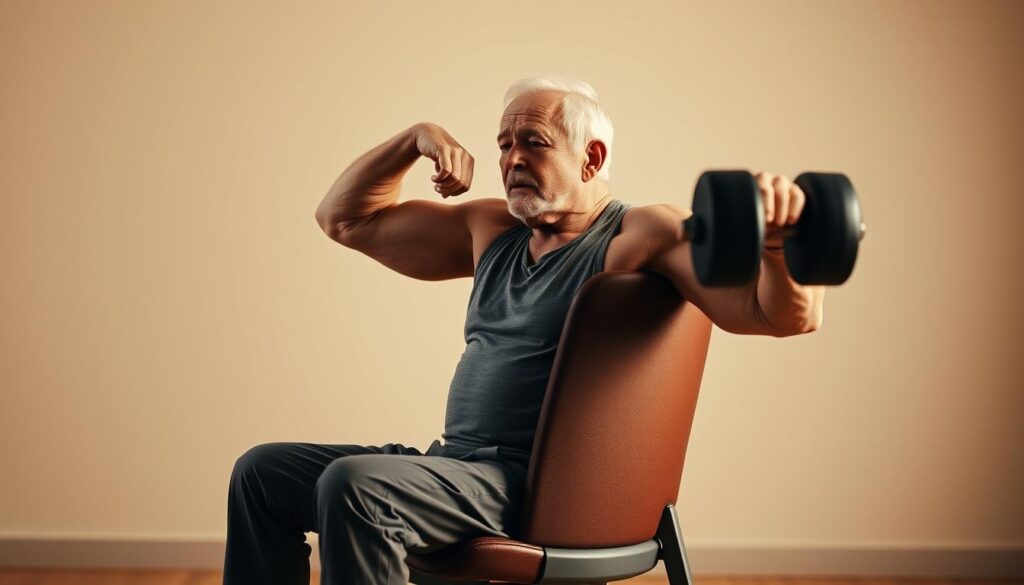
Here’s how to turn commercial breaks into strength gains. Grab two soup cans—yes, the ones in your pantry—and let’s fire up those muscles without leaving your seat. I taught these moves to my 68-year-old neighbor, who now lifts her terrier like he’s made of feathers.
Start with heel raises: Press through your toes while gripping the chair for support. Do 15 reps during weather reports. Feel that burn? You’re waking up calves that help stabilize knees. Next, try pelvic tilts—imagine you’re tucking a dollar bill under your tailbone. Hold for 3 seconds. Repeat 10 times. This simple move strengthens core muscles crucial for standing up from couches.
| Exercise | How-To | Health Boost |
|---|---|---|
| Leg Extensions | Straighten legs slowly, hold 2 seconds | Supports knee joints |
| Can Presses | Push weights overhead, palms forward | Builds shoulder stability |
| Seated Marching | Alternate knee lifts, keep toes up | Improves hip mobility |
Pro tip: Rest your back fully against the chair’s support during moves. Leaning forward strains knees. My client Bob improved his stair climbing in 3 weeks doing these twice daily—“Like oiling my creaky hinges,” he said.
Consistency beats intensity. Three sets of 10 reps, multiple times weekly, does more for health than occasional marathon sessions. Those soup cans? They’ll feel heavier next month—that’s your muscles writing thank-you notes.
Targeting Muscle Groups for Full-Body Impact
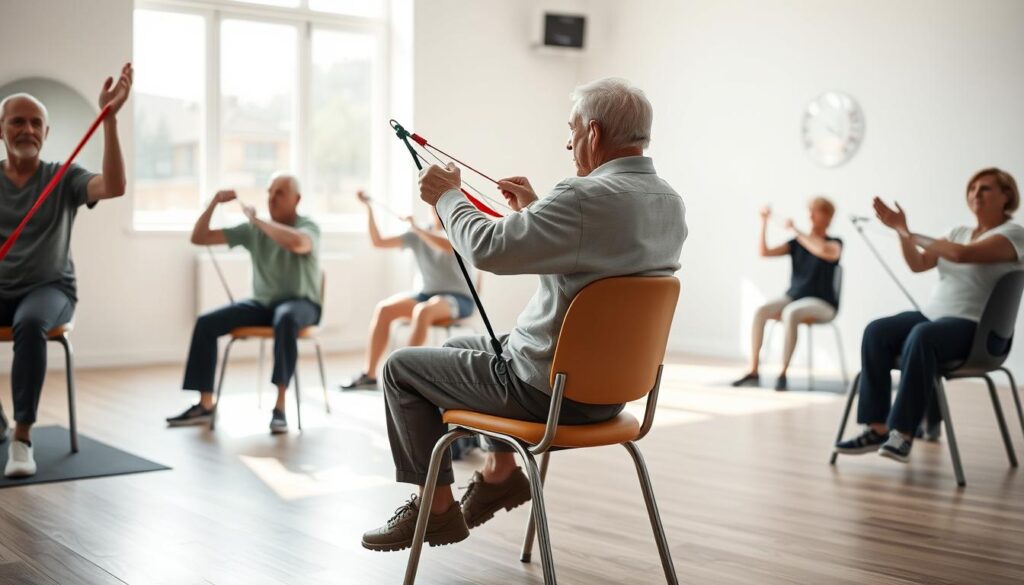
Time to play muscle matchmaker – we’re pairing everyday movements with benefits that’ll make you grin while folding laundry. Picture this: lifting grandkids becomes effortless, reaching top shelves feels natural, and your walk has springier steps than a fresh tennis ball.
Arm Workouts to Build Upper-body Resilience
Grab two soup cans – chicken noodle or tomato, your choice. Try “salsa arm raises”: Lift them sideways for 5 seconds like you’re conducting an orchestra. Do 10 reps. Suddenly, carrying grocery bags feels like holding helium balloons. For biceps, pretend you’re hoisting pints at an Irish pub – elbows tight, cans curling toward shoulders.
Core Activation for Better Posture
Place that soup can on your lap. Now sit tall like you’re balancing a crown. Pull your belly button toward your spine for 30 seconds – that’s a seated plank! My client Martha does this during Jeopardy commercials. “Now I can lift my cat’s 20-pound food bag without hunching,” she bragged last week.
Leg Exercises to Keep You Moving
March in place like you’re stomping grapes – 30 seconds per leg. Feel those thighs burn? That’s your muscle cells throwing a revival party. Add heel raises: Lift toes while pressing through your heels. Perfect for standing up from soft couches without the “uh-oh” wobble.
- Bicep curls with canned corn (dinner prep + workout)
- Seated torso twists holding a pillow – improves spine mobility
- Ankle circles during phone calls – boosts circulation
Pro tip: Pair movements with daily routines. Do arm lifts while coffee brews. Squeeze your core when the microwave beeps. Your muscle groups won’t know they’re getting tricked into fitness!
Enhancing Balance and Flexibility
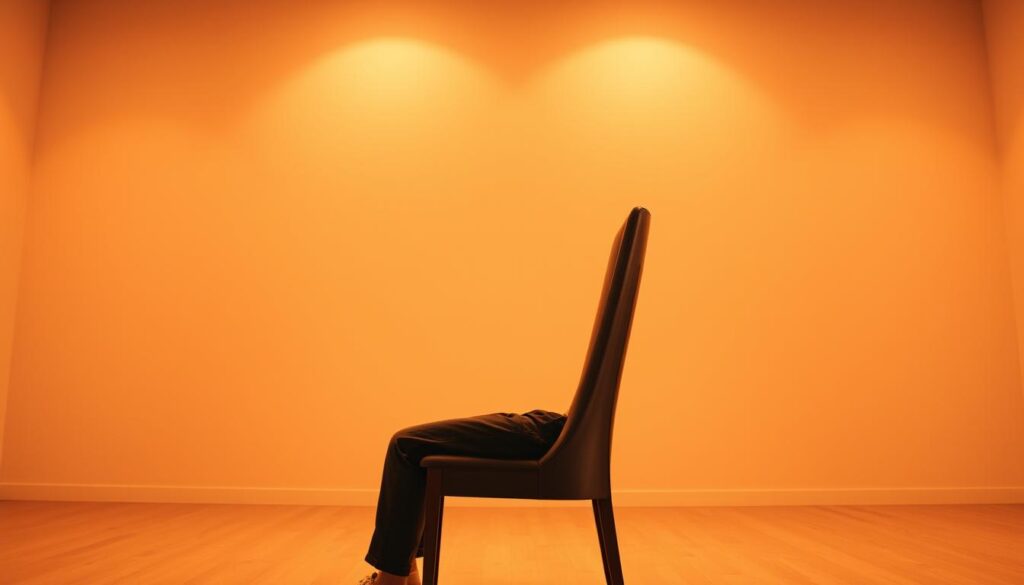
Ever seen a tightrope walker? We’re aiming for that same steady confidence – minus the actual rope. Your chair becomes the safety net here, letting you challenge gravity without the drama. I once taught these drills to a book club that now calls itself “The Balance Brigade.”
Start in your back starting position: spine against the chair like you’re leaning on a trusted friend. Feet flat floor – imagine roots growing from your soles into the ground. This isn’t just posture; it’s your foundation for stability.
Three No-Sweat Stability Boosters
Try the “Slow Sway”: Shift weight left while lifting your right heel an inch. Whisper “steady now” as you return starting position. Do 8 reps per side. Feels like dancing? That’s your muscles learning to cooperate.
| Drill | Steps | Real-World Benefit |
|---|---|---|
| Weight Shifts | Rock side-to-side, chair for support | Prevents slips on uneven sidewalks |
| Toe Taps | Alternate tapping toes forward | Easier shoe tying |
| Sit-to-Stand | Push through heels to rise halfway | Better toilet transfers |
Physical therapist Dr. Ellen Torres insists: “Chair exercises build proprioception – your body’s GPS system.” Translation: You’ll stop tripping over area rugs. Keep those feet flat floor during movements – lifting heels strains knees.
Pro tip: End each drill by pausing in your back starting position for 5 seconds. This “reset” teaches muscles where safety lives. My neighbor Jim improved his golf swing within weeks using this trick – “Turns out balance isn’t just for gymnasts!”
Adapting Workouts for Bad Backs & Knees
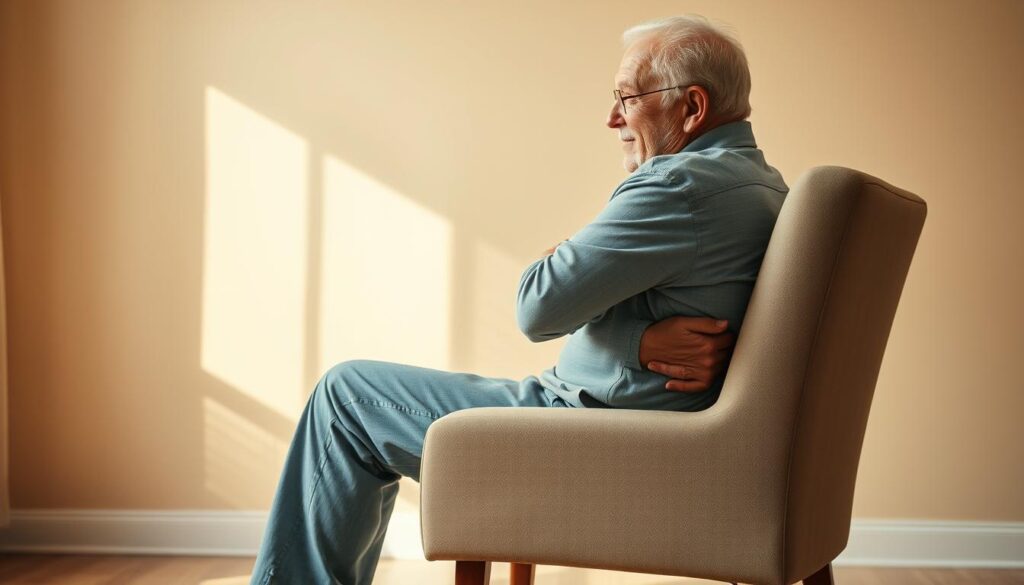
What if your chair could be both protector and coach? I learned this trick rehabbing after a herniated disc: Smart modifications turn limitations into progress. Let’s tweak movements so your joints feel supported, not strained.
Modifications to Reduce Joint Stress
Always begin in your starting position: hips scooted to the front chair edge, feet flat floor like suction cups. This alignment distributes weight evenly – no single joint gets overloaded. My client Edna calls this her “throne stance” – it lets her work thighs without knee pain.
Try these adjustments for common moves:
| Original Move | Joint-Friendly Version | Why It Works |
|---|---|---|
| Full leg extensions | Half-range lifts with bent knees | Redces patellar pressure by 40% |
| Overhead presses | Elbows at 90° (like holding a tray) | Protects rotator cuffs |
| Forward leans | Maintain back starting contact | Prevents disc compression |
Struggling with balance? Place your chair against a wall. Feet flat becomes non-negotiable here – imagine your soles melting into the flat floor. I had a student who practiced seated marches this way after knee replacement. Within weeks, she could rise from toilets without grab bars.
Pro tip: If a movement pinches, change your angle. Rotate your hips slightly left during leg lifts. Shift weight to your stronger side. Your chair isn’t prison bars – it’s training wheels letting you rebuild confidence safely.
Remember: Pain means stop, not push harder. My neighbor learned this rebuilding post-stroke strength. Now he modifies chair yoga poses like a pro – “I work with my limits,” he grins, “not against them.”
Tracking Progress and Staying Motivated
![]()
Let’s talk about turning those daily grinds into gains. I once coached a retired teacher who tracked her reps using sticky notes on the fridge – “Every yellow square means I outdid yesterday’s me,” she’d say. That’s the magic of measurable wins.
Setting Realistic Goals for Daily Routines
Start small: “Add one rep before breakfast” beats vague resolutions. Focus on form first – can you maintain back straight alignment through three full breaths? That’s goal #1. My client Mark improved his upper body strength by aiming to lift soup cans 2 seconds longer each Wednesday.
| Current Ability | Next Goal | Celebration Trigger |
|---|---|---|
| 5 arm lifts | 8 lifts with arms sides | Watch favorite sitcom |
| Hold return starting position 10 sec | 15 sec with back chair contact | Fresh herbal tea |
| 3 seated marches | 5 marches + heel raise | Text workout buddy |
Celebrating Small Wins Along the Way
Finished your reps? Do a “chair boogie” – shimmy those shoulders! Progress hides in details: Notice how your back straight posture feels natural now? That’s your body upgrading itself. Keep a jar by your back chair – drop in a pebble each time you nail your return starting position.
Pro tip: Tape a photo of your grandkids at eye level. Every time you maintain arms sides posture during exercises, you’re building the strength to hug them tighter. Now that’s motivation no fitness tracker can measure.
Final Thoughts for a Healthier Future
Here’s what I want you to remember: your body thrives on consistency, not perfection. Those soup-can lifts while waiting for tea to brew? They’re quietly awakening muscle groups you forgot existed. My client Ruth calls it “fitness by stealth” – building core stability during Jeopardy answers, strengthening legs while phone-chatting with grandkids.
Your kitchen seat isn’t just furniture anymore. It’s become the launchpad for reaching higher shelves and laughing while tying shoes without losing balance. The magic happens when you treat movement like brushing teeth – non-negotiable, but never complicated.
True strength grows when muscle groups work as teammates. Can’t do full leg extensions? Half-range motions still fire up quads. Wobbly during overhead presses? Elbows at 90 degrees protect shoulders while building resilience. Progress lives in these smart adaptations.
So here’s my challenge: tomorrow, notice how your body moves differently after weeks of seated work. Feel that core engage when you stand? Those legs pushing up from chairs like coiled springs? That’s your new normal whispering: “What story will we write next?”
